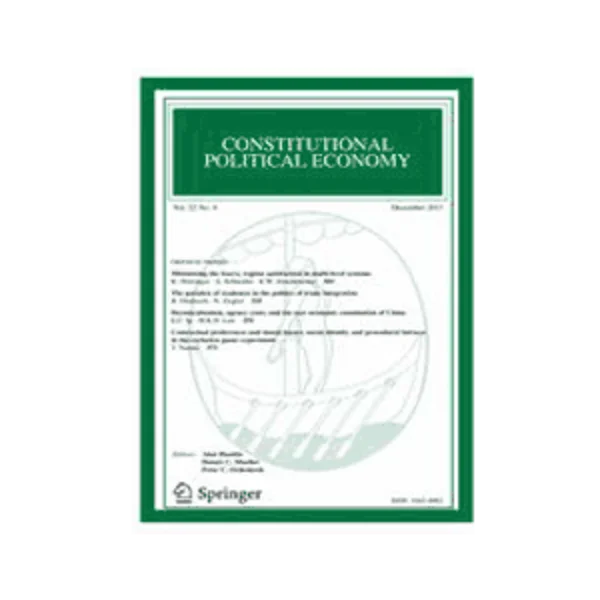-
the political economy of public debt
جزئیات بیشتر مقاله- تاریخ ارائه: 1392/07/24
- تاریخ انتشار در تی پی بین: 1392/07/24
- تعداد بازدید: 1075
- تعداد پرسش و پاسخ ها: 0
- شماره تماس دبیرخانه رویداد: -
public debt (as opposed to current taxation) alters the inter-temporal pattern of tax rates—it reduces current rates and increases future rates. accordingly, whether the share of the cost of a given public expenditure is reduced or increased by debt for a given individual depends on the time profile of that individual’s income (tax base) vis-à-vis others’ incomes. therefore, given the age-profile of income in virtually all western countries, individuals will tend to be better off under current taxes the younger they are. if (as most standard models of political economy assume) individuals vote according to their economic interests, and if they are tolerably well-informed, then the pattern of support for public debt will track age. and increases in the median age of the population will lead to larger public debt. in other words, public debt policy collapses to a kind of demographic politics. this explanation may, however, be sensitive to assumptions about motives for bequest. specifically, if bequestors seek to leave positive bequests and are motivated exclusively by the lifetime consumption of their heirs (as well as themselves) then the aged may, under plausible assumptions about the age of their heirs, prefer current taxes over debt.
مقالات جدیدترین رویدادها
-
استفاده از تحلیل اهمیت-عملکرد در ارائه الگوی مدیریت خلاقیت سازمانی و ارائه راهکار جهت بهبود
-
بررسی تاثیر ارزش وجوه نقد مازاد بر ساختار سرمایه شرکت های پذیرفته شده در بورس اوراق بهادار تهران
-
بررسی تأثیر سطح افشای ریسک بر قرارداد بدهی شرکت های پذیرفته شده در بورس اوراق بهادار تهران
-
بررسی تأثیر رتبه بندی اعتباری مبتنی بر مدل امتیاز بازار نوظهور بر نقد شوندگی سهام با تأکید بر خصوصی سازی شرکت ها
-
تأثیر آمیخته بازاریابی پوشاک ایرانی بر تصویر ذهنی مشتری پوشاک ایرانی (هاکوپیان)
-
تاثیر اندیشه اکو سوفیسم بر توسعه پایدار معماری شمال ایران
-
تحلیل عوامل موثر بر گسترش گردشگری در منطقه توریستی موگرمون شهرستان لنده با استفاده از مدل برنامه ریزی راهبردی (s)
-
ارائه الگویی برای مدیریت پروژه ارزش محور در طرح های عمرانی
-
بررسی خطوط تسلیم در ورق های فولادی
-
a united deformation-strength framework for lightweight sand–eps beads soil (lses) under cyclic loading
مقالات جدیدترین ژورنال ها
-
مدیریت و بررسی افسردگی دانش آموزان دختر مقطع متوسطه دوم در دروان کرونا در شهرستان دزفول
-
مدیریت و بررسی خرد سیاسی در اندیشه ی فردوسی در ادب ایران
-
واکاوی و مدیریت توصیفی قلمدان(جاکلیدی)ضریح در موزه آستان قدس رضوی
-
بررسی تاثیر خلاقیت، دانش و انگیزه کارکنان بر پیشنهادات نوآورانه کارکنان ( مورد مطالعه: هتل های 3 و 4 ستاره استان کرمان)
-
بررسی تاثیر کیفیت سیستم های اطلاعاتی بر تصمیم گیری موفق در شرکتهای تولیدی استان اصفهان (مورد مطالعه: مدیران شرکتهای تولیدی استان اصفهان)
-
عوامل بحران موفقیت مدیریت پروژه فناوری اطلاعات در بین کارکنان شهرداری های استان گیلان
-
حیله شرعی در عقود
-
the relationship between strategic human resource management and job performance with the role of knowledge management sayyad shirazi hospital staff gorgan
-
numerical investigation of stress block for high strength concrete columns
-
frequency and causes of fluid accumulation in the adjacent space in patients admitted to teaching hospitals in urmia




سوال خود را در مورد این مقاله مطرح نمایید :